Top 30 Gemstone Types You Need to Know
The Lustrous Journey: of 30 well-known and desirable gemstone types:
You are about to embark on an exciting exploration into the sparkling world of gems. “The Lustrous Journey: gemstones, ” illustrates the vivid characteristics and symbolisms of these precious stones in a way that will leave you appreciating their beauty and value even more.
Understanding the Gemstones: Diamond, Sapphire, Ruby, Emerald and Amethyst
Gemstones are nature’s most fascinating creations, with each one having its unique characteristics. This article will discuss 30 of the most popular gemstones:
Overview of the five precious stones
The first five gemstones we will see are Diamond, sapphire, ruby, emerald, and amethyst each holds its place in the realm of gemstones based on their crystal structure, color, hardness, and luster. Diamonds, widely famed for their unsurpassed strength and shimmer, are the hardest substances on earth, rating a 10 on the Mohs Hardness Scale. Sapphires and rubies come from the same gem family, called corundum, and rank 9 on the Mohs Hardness Scale. Emeralds, known for their lush green hues, belong to the beryl mineral family. Lastly, the amethyst, a form of quartz known for its iconic purple color, scores a 7 on the Mohs hardness scale.
Unique characteristics of each gemstone
Each gemstone has its unique characteristics, making them highly demanded. Diamonds, for example, are renowned for their exceptional brilliance and fire. They transmit and reflect light to a high degree, making them the most lustrous of all gemstones. Sapphires are beloved for their rich blue color, though they come in every color except red. Rubies, on the other hand, are the red variety of sapphire. Emeralds are best known for their verdant hues, varying from bluish to pure green. Amethysts are known for their striking purple color, which can range from light lavender to deep violet.
Pros and cons of each gemstone
Diamonds offer the advantage of extreme durability, which is why they’re often chosen for engagement rings. However, they can be expensive, and the industry has been criticized for its ethics and sustainability. Sapphires are likewise incredibly durable, affordable, and available in a rainbow of colors, but they may require heat treatment to improve their color. Rubies share the benefits and drawbacks of sapphires since they are essentially the same stone. Emeralds carry a rich color and historical significance, but they lack hardness and require more care. Amethysts offer affordability and a captivating color, but they also lack the durability of other gemstones. https://www.gia.edu/gia-bangkok
The Making of Diamonds: Formation Process

Diamond, round brilliant
Diamonds are significant geological wonders. They form under very specific conditions that occur deep within the Earth’s mantle.
The specific geological conditions required for diamond creation
Diamonds form under high-pressure, high-temperature conditions at depths of over 140 kilometers within the Earth’s mantle. Here, they crystallize from carbon-rich fluids.
How extreme pressure and heat form a diamond
The extreme pressures and temperatures at these depths force the carbon atoms to arrange themselves into a crystal lattice structure, creating a diamond. Once formed, they are brought up to the surface by volcanic eruptions, and encased in kimberlite or lamproite pipes.
Factors influencing the quality and size of diamonds
Factors that influence the size and quality of a diamond include the conditions under which it forms, the amount of carbon available, and how long it remains under extreme pressures and temperatures. Additionally, any impurities present during the formation can affect the diamond’s color.
Diamond Mining and Extraction Techniques
Diamond mining is a global industry and has evolved significantly over the centuries.
Popular diamond mining countries
Prominent diamond-producing countries include Russia, Botswana, Canada, and South Africa. These countries are known for their exceptionally large diamond mines, some of which are the most substantial on earth.
Different methods of diamond mining
Techniques used to extract diamonds vary, from open-pit mining to underground mining and alluvial mining. Open-pit mining involves the removal of layers of soil and rock to expose the kimberlite pipes, while underground mining accesses diamonds deep within the Earth. Alluvial mining, on the other hand, extracts diamonds from deposits in riverbeds and coasts.
Ethical considerations in the diamond mining industry
A significant issue in the diamond mining industry revolves around ethical considerations, such as human rights and environmental impact. This has led to an emphasis on responsible mining practices and the emergence of the conflict-free diamond movement.
Diamond Cutting and Polishing
Diamond cutting is an intricate process that transforms a rough diamond into a finished gem.
Techniques of shaping a rough diamond into a finished gem
The process begins with a careful analysis of the diamond to determine the best approach to maximize carat weight, color, and clarity. Skilled artisans then use a mechanical saw to shape the diamond, before bruting or roughing to create the shape of round diamonds.
The art and science of facet cutting
Facet cutting, a significant aspect of diamond cutting, is both a science and an art. The facets must be aligned precisely to achieve the brilliance and fire for which diamonds are renowned.
Deciding the shape and size of the finished diamond
The facet cutter also decides the shape and size of the finished diamond, typically aiming for the maximum carat weight. The final shape could be round, marquise, pear, princess, or one of many other fancy shapes.

Blue sapphire gemstone
The Journey of Sapphire: Formation Process
Just as with diamonds, sapphires also require specific conditions for formation.
Understanding the geological requirements for sapphire creation
Sapphires form under extreme temperatures and pressure, usually in metamorphic or igneous rocks. The mineral corundum combines with trace amounts of other elements, such as iron and titanium, to produce the gemstone. Are Star Sapphires Worth Anything?
How different elements and conditions affect the color of sapphires
Depending on the presence of different trace elements, sapphires may take on different colors. For instance, iron and titanium result in the traditional blue sapphires, while the presence of chromium results in pink or red corundum, known as ruby.
Key factors determining the quality and price of sapphires
The quality of a sapphire is determined by its color, clarity, cut, and carat weight. The most valuable sapphires are a vibrant, deep blue with few inclusions visible to the naked eye.
Sapphire Mining and Extraction Techniques
Sapphire mining is likewise a significant industry, with specific techniques used to extract the gemstones.
Major sapphire mining countries
Key sapphire-producing countries include Sri Lanka, Madagascar, Myanmar, and Australia, each possessing distinctive types and colors of sapphires.
Differences in mining techniques between diamond and sapphire
Unlike diamond mining, sapphire mining doesn’t often require sophisticated machinery. Instead, artisanal miners in many countries manually dig pits and sift through the gravel to find the gemstones. Which Finger Do You Wear Black Sapphire Ring On?
Environmental and ethical considerations in sapphire mining
Due to the lower capital intensiveness, the sapphire mining industry has less environmental impact than diamond mining. However, the industry still faces challenges related to labor conditions and ensuring a fair supply chain.
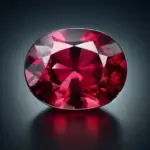
Ruby gem
From Ruby to Emerald: Formation and Mining Process
Given that rubies are a variety of the mineral corundum, they share the formation process with sapphires. Emeralds, however, form under different conditions.
Formation process of rubies and emeralds
Rubies form in the mineral corundum like sapphires, with the color determined by the presence of chromium. Emeralds are part of the beryl family, along with aquamarine and morganite. They form in a three-part process involving a reaction between beryllium, chromium or vanadium, and vanadium.
Key mining regions of rubies and emeralds
Concerning rubies, Myanmar is famously known for its “pigeon blood” rubies. Other significant producers include Thailand and Cambodia. Major emerald-producing countries are Colombia, Zambia, and Brazil.
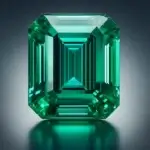
Emerald gemstone
Challenges and ethical considerations in mining
Both ruby and emerald mining face challenges, including poor working conditions in mines and environmental degradation. Like other gemstones, there’s a crucial need for responsible sourcing in both ruby and emerald mining.
Amethyst: The Purple Gemstone
Amethysts are a variety of quartz, offering a beautiful range of purple colors.
Overview of the amethyst formation process
Amethysts form from silicon dioxide in hollow cavities or geodes within rocks. Clear quartz crystals become amethyst when irradiated with certain levels of radioactivity, which causes the trace amounts of iron within the crystals to turn a deep purple color.
Major amethyst mining regions
Major sources of amethyst include Brazil, Uruguay, and Zambia. The gemstone is also found in various locations throughout the United States, including Arizona, Texas, and Maine.
Impact of geological conditions on the color saturation of amethyst
The degree of color saturation in an amethyst is highly dependent on specific geological conditions during its formation. The presence of iron and the level of radiation are the most notable factors in creating amethyst’s vivid purple hues.
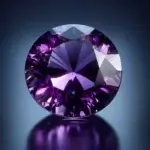
Amethyst gem
Jewelry Crafting: Incorporating the Gems
Crafting jewelry involves careful planning and exacting techniques to highlight the beauty of gemstones.
Deciding the perfect setting for the gemstones
Selecting the perfect setting for a gemstone is a critical decision when making jewelry. It depends on the stone’s shape, size, color, and clarity, as well as the intended use of the jewelry.
Traditional vs contemporary designs
There is a broad spectrum of designs ranging from traditional to contemporary. Traditional designs often feature intricate details and classic gemstone shapes. In contrast, contemporary designs trend toward minimalist and geometric styles.
Techniques of fastening the gemstones onto jewelry
Different setting techniques are used to fasten gemstones onto jewelry. They include prong, bezel, channel, and pave settings. Each technique offers a different aesthetic, providing a myriad of design possibilities.
Market Evaluation: Buying and Selling Gems
Trading gemstones requires specialized knowledge to ensure fair deals and ethical practices.
Understanding the global market for gemstones
The global market for gemstones is vast, encompassing mines, gem cutters, wholesalers, jewellers, and consumers. Furthermore, it includes both the physical marketplaces and online platforms.
Determining the value of a gemstone
The value of a gemstone is determined by the “Four Cs”: cut, carat weight, color, and clarity. Added to this are factors like the origin and presence of treatments.
How to buy and sell gemstones responsibly
Buying and selling gemstones responsibly means considering ethical sourcing, supporting industries that treat workers fairly, and upholding sustainability in all their operations. One way to ensure this is by seeking out certified conflict-free gemstones and buying from companies that support responsible mining practices.
The Lustrous Journey of Aquamarine, Opal, Pearl, Topaz, and Turquoise
the illustrious history and fascinating origins of Aquamarine, Opal, Pearl, Topaz, and Turquoise, you’ll discover the lore, formation processes, and cultural significance of these dazzling gemstones. Rest assured, your inner gemologist will surely sparkle with new-found knowledge and appreciation. So brace yourself for “The Lustrous Journey of Aquamarine, Opal, Pearl, Topaz, and Turquoise,” a tale as vibrant and captivating as the gemstones themselves.

Aquamarine gem
History and Origin of Aquamarine
Aquamarine, with its mesmerizing sea-blue green color, has fascinated mankind since ancient times. Believed to be the treasure of mermaids, it carries the calming, soothing energy of the ocean.
Ancient beliefs and uses of Aquamarine
History is a testament to the belief that Aquamarine was a gem of good luck, fearlessness, and protection. Sailors often wore it as an amulet for safe and prosperous journeys. The Romans associated it with youth and happiness, while the Greeks used it for oracles. This precious gemstone also graced the crowns of ancient kings and queens, symbolizing endless love.
Significant occurrences and quality deposits
Aquamarine has been found all around the world. Prominent deposits occur in Brazil, Pakistan, Afghanistan, Australia, and parts of the United States. Brazil, with its prolific production, stands out as the primary source of this charming gemstone.
The process of formation of Aquamarine
Aquamarine is a variety of Beryl, which forms deep within Earth’s crust over millions of years. The unique, serene color comes from the presence of iron impurities. In its purest form, it features a softly saturated blue-toned green that mirrors the soothing allure of the sea.
Properties of Aquamarine
Aquamarine is famed not only for its captivating color but also for its impressive properties.
Physical and chemical properties
Enriched with beryllium aluminum silicate, aquamarine is durable and transparent. It refracts light well and maintains its sparkle, making it a popular choice for jewelry pieces.
Crystal structure and hardness
Aquamarine has a hexagonal crystal structure. It is a relatively hard gemstone, measuring 7.5-8 on the Mohs hardness scale. This hardness adds to its desirability, as it allows the gem to withstand daily wear and tear.
Variations in color and clarity
Color and clarity both play significant roles in determining the quality of aquamarine. The more intense the blue color, the higher the value. Moreover, aquamarines are often nearly flawless, further enhancing their appeal.
Cleaning and care for Aquamarine
Cleaning aquamarine requires a gentle touch. Mild soap and warm water is typically all that’s needed for cleaning. Ultrasonic cleaning is generally safe, but steam cleaning should be avoided as it may cause the gem to fracture.
Symbolism and Healing Powers of Aquamarine
Aquamarine symbolizes a host of positive attributes and is believed to possess healing energies.
Aquamarine in folklore and mythology
Aquamarine has a rich tradition in folklore and mythology. Sailors believed that this gem would ensure a safe journey, while others used it as a charm for a happy marriage.
Promised effects on emotional and physical health
In the healing realm, aquamarine is believed to soothe the mind and calm emotions. It’s said to enhance clarity, improve communication, and support physical healing, particularly of throat-related illnesses.
Aquamarine in meditation and spiritual practices
On a spiritual plane, aquamarine is often used in meditation practices. Its tranquil blue-green shade is believed to promote spiritual growth, inspire tranquility, and increase awareness.

Black Opal
History and Origin of Opal
Opals, with their galaxy of colors, have been the epitome of mystery and beauty throughout history.
Early uses and cultural significance of Opal
Opal has been used as a gemstone for thousands of years. Aboriginal Australians believed that it brought about good luck and were revered as containing the spirit of the sky god. In medieval Europe, they were regarded as highly beneficial, providing great luck as it carried all the virtues of each gemstone in the opal’s color spectrum.
Valuable Opal sites and their discovery
Opals are predominantly found in Australia, which accounts for around 95% of the world’s opals. Other significant deposits exist in the United States, Ethiopia, and Mexico.
Understanding the formation of Opal
Opal is a hydrated amorphous form of silica. Its formation is a marvel of nature that takes place when an arrangement of silica spheres forms a grid-like pattern, causing the diffraction of light and the consequent display of iridescent colors.
Properties of Opal
The unique properties of opals have made them a gemstone of desire and intrigue.
Examining the unique physical properties
The colorful play-of-color is the most defining property of opals. This phenomenon occurs due to the intricate arrangement of tiny silica spheres within the stone.
Color spectrum and ‘play-of-color’ phenomenon
Opals can exist in many colors, including white, black, fire, and boulder. The value of an opal is determined predominantly by the play of color across its surface.
Maintenance and care instructions for Opal
Opals are relatively delicate gemstones that require proper care. They should be stored in a moist environment to prevent cracking, and shielded from sudden temperature changes.
Symbolism and Healing Powers of Opal
Opals have been attached to a wealth of mystical properties and healing energies.
Opal in various cultural narratives
Opal has featured prominently in cultural narratives. Aboriginal Australians regarded them as the creator’s footprints, while the Ancient Greeks believed they were the tears of joy wept by Zeus after the defeat of the Titans.
Health benefits associated with Opal
Opals are believed to bring about the qualities of love, passion, lightness, and creativity. They are also used in healing practices to enhance mental clarity, emotional stability, and general bodily health.
Use of Opal in spiritual and psychic practices
In spiritual and psychic practices, opal is often used to enhance cosmic consciousness and encourage psychic and mystical visions.
History and Origin of Pearl
Pearls have long been associated with wealth and royalty and are considered one of the world’s most luxurious gems.
Role of Pearl in early human adornment
Pearls have been used as adornment for millenniums. Archaeological evidence suggests that they were used in jewelries in ancient Persia, Rome, Greece, and China. They were considered the ultimate symbol of wealth and status.
Historic Pearl-producing locations
Various types of pearls are historically harvested from rivers and seas around the world. The Persian Gulf was noted for its high-quality pearls. Today, most pearls used in jewelry are cultured or farmed, with Japan and China being the largest producers.
Natural versus cultured Pearl formation
Natural pearls are formed when an irritant becomes trapped inside a mollusk. The mollusk then secretes a substance called nacre around the irritant, forming a pearl. Cultured pearls, on the other hand, are created when a bead is introduced into the mollusk intentionally.
Properties of Pearl
Pearls are famous for their unique properties, particularly their luster and beauty.
Fundamental physical properties
Pearls are organic gemstones originating from living sea creatures. They possess a smooth, rounded shape with a lustrous and reflective surface, and are available in various colors depending on the type of mollusk and water where they grow.

Pearl
Classification and grading of Pearls
Pearls are classified by their origin and then graded by their luster, nacre quality, shape, surface perfection, color, and size. The highest quality pearls are ones with the deepest, most radiant luster.
Preserving and cleaning Pearls carefully
Pearls are soft and require careful handling. They should be kept away from chemicals, including makeup and perfume. Cleaning should be done with a soft, damp cloth.
Symbolism and Healing Powers of Pearl
Throughout history, pearls have been believed to have restorative and healing properties.
Pearl in religious texts and myths
Pearls have symbolized purity, integrity, and wisdom in various cultures. They are mentioned in the Bible, the Quran, and were considered tears of gods in ancient mythology.
Health Impacts Tied to Pearl
Pearls are thought to have health benefits, particularly in matters of the mind. They are known to have a calming effect and are used to treat insomnia and maintain the body’s natural rhythms.
Pearl use in spiritual healing
In spiritual terms, pearls are used in deeply understanding oneself and one’s purpose in life. They are believed to attract wealth and luck as well as offer protection.

Turquoise gem
Symbolism and Healing Powers of Turquoise
Turquoise is famed for its unique blue-to-green color and its spiritual significance.
Turquoise in historical stories and myths
Turquoise has held a high place in religious and tribal cultures. Native Americans believe turquoise can bring rain, while in Buddhism, it is one of the “seven treasures” in Tibetan culture.
Reported health benefits of Turquoise
Many health benefits are attributed to turquoise, including healing emotional wounds and relieving stress. It’s associated with the immunity system and is believed to have detoxifying effects.
Use of Turquoise in spiritual and therapeutic practices
On a spiritual level, turquoise is seen as a bridge between heaven and earth. It’s often used in meditation and mindfulness practices and is believed to offer protection and promote balance.

Topaz gem
**Topaz**
Topaz dazzles with vibrant hues and historical reverence, believed by Ancient Greeks to bestow strength. The rare Imperial Topaz in golden-orange to pink is the most prized, while Blue Topaz is enhanced by heat or radiation treatments. Known for its calming energies, Topaz aids in digestion and curbs violent impulses, making it a popular choice for both jewelry and artistic creations.
**Garnet**
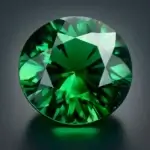
Tsavorite garnet
Garnet’s deep red allure, symbolizing love and vitality, spans a variety of colors from the well-known Almandine to the vibrant green Tsavorite. Esteemed since ancient Egypt and popular in Victorian jewelry, Garnet enhances relationships, boosts metabolism, and is favored in engagement rings due to its intense, durable nature.

Peridot gemstone
**Peridot**
Unique for its singular green color, Peridot ranges from olive to lime green based on its iron content. Celebrated in ancient Egypt as the “gem of the sun” and in Hawaiian folklore as the tears of Pele, Peridot is believed to bring positive energy, success, and peace, making it a fresh alternative in modern jewelry for those seeking a distinctive, vibrant gemstone.
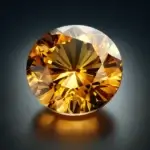
Citrine
**Citrine**
Bright and cheerful, Citrine is formed when amethyst is heated, transforming into shades from reddish-orange to pale yellow. Known as the ‘Merchant Stone’, it is associated with wealth and prosperity and is often used in feng shui. Citrine’s sunny hues make it a popular choice for engagement rings and contemporary jewelry styles.

Quartz gem
**Quartz**
Quartz, one of the most versatile minerals, includes varieties like amethyst, smoky quartz, and rose quartz. Revered across cultures for its spiritual significance, it is known as the “master healer,” amplifying energy and intentions. Its diverse colors and forms make Quartz a staple in fashion, offering options for every style from minimalist to extravagant.
This journey through the world of gemstones not only enriches your appreciation for their beauty but highlights their cultural significance and timeless charm in the world of jewelry and beyond.
“Exploring the Magnificent World of Jade, Alexandrite, Moonstone, Morganite, Tanzanite, and Onyx,” a fascinating tour through the realms of these exceptional gemstones, each with unique properties and intriguing histories.
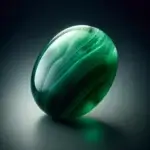
Jadeite, Jade
**Jade**
Renowned for its smooth texture and calming green color, Jade holds significant cultural importance in East Asia and Mesoamerica. Predominantly mined in Myanmar, Jade comes in two types: Nephrite, known for its creamy hues, and Jadeite, valued for its vibrant greens. Used in jewelry and intricate carvings, Jade combines durability with aesthetic appeal.

Alexandrite gem, color change stone
**Alexandrite**
Alexandrite mesmerizes with its color-changing ability, appearing green in daylight and red in incandescent light. First discovered in Russia, this rare gem symbolizes luck and love and is highly prized in jewelry for its distinct colors and rarity.

Blue sheen Moonstone
**Moonstone**
Moonstone charms with its ‘adularescence’—a shimmer that moves with the light, reminiscent of moonlight. Valued for its connection to love and femininity, particularly in India, Moonstone is popular in modern jewelry for its ethereal glow.
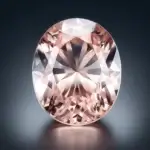
Morganite gem
**Morganite**
Known for its soft pink color, Morganite is a newer yet beloved gemstone, associated with love and compassion. As a member of the Beryl family, it shares characteristics with Emerald and Aquamarine but stands out for its clarity and is often featured in engagement rings.
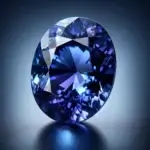
Tanzanite
**Tanzanite**
Found only in Tanzania, Tanzanite is a thousand times rarer than diamonds. This gem exhibits pleochroism, showing different colors from various angles, making it a favorite in contemporary jewelry for its deep blue and violet hues.

Onyx stone
**Onyx**
Onyx is celebrated for its deep black color and glossy finish, historically used for cameos and now popular in modern jewelry for its bold, elegant appearance. It symbolizes protection and emotional strength, absorbing negativity to promote emotional well-being.
Dive into “The Precious Stones: Spinel, Tourmaline, Zircon, and Lapis Lazuli,” a captivating exploration into the depths of these gemstones, each boasting unique origins and enduring allure. From the vibrant tourmaline to the tranquil blues of lapis lazuli, discover their rich histories and symbolic meanings.
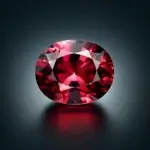
Red Spinel
**Spinel**
Often mistaken for ruby or sapphire, spinel stands out with its array of colors from deep reds to vibrant blues, thanks to various trace elements. Historically cherished in royal crown jewels, spinel is recognized for its hardness (8 on the Mohs scale) and geometric clarity. Found primarily in Myanmar, Sri Lanka, and other locations, it is best maintained by gentle cleaning with soapy water.
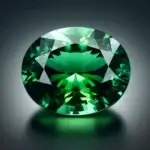
Green Tourmaline gemstone
**Tourmaline**
Known for its extensive color range, tourmaline can appear in almost any hue, with its chemical composition influencing its vibrant colors. Highly valued in jewelry for its durability and vivid colors, tourmaline is mined across the globe from Brazil to Madagascar. It requires care to avoid exposure to heat and harsh chemicals.
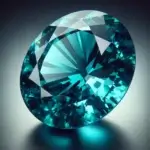
Zircon
**Zircon**
As one of the oldest gemstones on Earth, zircon varies in color from gold to blue, often used as a diamond alternative due to its brilliant luster. Found in ancient Australian deposits, zircon’s durability and fire make it ideal for various jewelry settings. Care for zircon involves avoiding abrasive cleaners to maintain its integrity.

Lapis Lazuli rough
**Lapis Lazuli**
Esteemed for its deep celestial blue, lapis lazuli has been a symbol of royalty and spirituality for thousands of years. Primarily sourced from Afghanistan, it often features golden pyrite flecks. Lapis is used in various decorative arts and is best cared for by avoiding strong chemicals and using only mild soap for cleaning.
This concise overview offers a glimpse into the remarkable characteristics and care for each of these gemstones, celebrating their historical significance and unique beauty.
“The Precious Stones: Agate, Malachite, Labradorite, Ametrine, Chrysocolla, Iolite, and Kunzite.” This unveils the unique characteristics and histories of each gem, highlighting their allure and cultural significance.
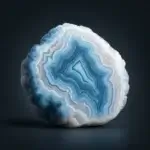
Agate
**Agate**
Agate, a variety of quartz, forms in layers within volcanic rocks, creating distinct patterns. Known for its durability and array of types—such as Blue Lace and Crazy Lace—agate has been used historically for protection and health, and continues to be popular in modern jewelry due to its versatility and beauty.

Malachite
**Malachite**
Characterized by its vivid green bands, malachite forms through the reaction of copper deposits with carbonate and water. It was historically ground for pigments and carved into ornaments. Today, it’s prized in jewelry for its bold, green patterns and is easily maintained with mild soap and water.
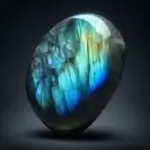
Labradorite
**Labradorite**
Famous for its labradorescence, labradorite displays mesmerizing color shifts due to its unique mineral structure. Initially found in Labrador, Canada, it’s regarded as a mystical stone that protects and enhances creativity. It’s used extensively in modern designs for its captivating visual effects.
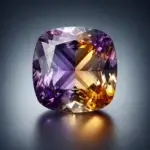
Ametrine
**Ametrine**
Ametrine uniquely blends the colors of amethyst and citrine within single quartz crystals, displaying segments of purple and gold. Rare and primarily sourced from Bolivia, it’s valued for its color contrast and is popular in jewelry that showcases its dual hues.

chrysocolla
**Chrysocolla**
Known for its vivid blue and green colors, chrysocolla forms through the oxidation of copper ores. It is revered for its calming qualities and aesthetic appeal, often featured in bold jewelry designs that highlight its rich, vibrant patterns.

Iolite gem
**Iolite**
Often referred to as ‘water sapphire,’ iolite exhibits shades of violet and blue depending on the angle. It was historically used by Vikings for navigation due to its pleochroic properties. Today, iolite is cherished in jewelry for its striking, sapphire-like appearance and its ability to inspire creativity and vision.
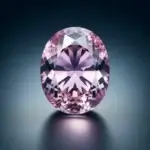
Kunzite
**Kunzite**
Named after gemologist George Frederick Kunz, kunzite is admired for its soft pink to light violet shades. A relatively new gemstone, it’s popular in feminine jewelry designs and requires careful handling to avoid fading. Its gentle hues are believed to promote love and harmony.
**The Allure of Sunstone**
Sunstone is a gemstone celebrated for its sun-like radiance, with a sparkling appearance that captivates jewelry lovers and collectors. Often found in Southern Norway, Sweden, the USA, and India, it forms from cooling magma that embeds tiny reflective crystals, giving it an eye-catching aventurescence.
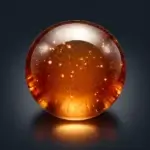
Sunstone
**Characteristics of Sunstone**
Sunstone features a unique glitter, known as aventurescence, caused by copper or hematite inclusions that reflect light, mimicking sunlight. This effect enhances its range of colors, from golden to orange and even rare green shades, each enriched by light-reflecting minerals.
**Sunstone in Jewelry**
Due to its durability and vibrant sparkle, Sunstone is ideal for various jewelry types, including rings, bracelets, and necklaces. It pairs well with gold settings, offering a warm glow, and stands out alongside darker stones due to its bright luster.
**Metaphysical Attributes**
Symbolically, Sunstone represents freedom and self-empowerment, believed to hold the sun’s positive energy to foster enthusiasm and uplift spirits. While valued for these metaphysical properties, it’s important to note these should complement, not replace, professional medical advice or treatment.
**Care and Purchasing Tips**
These gemstones, each with their own maintenance needs, generally require gentle cleaning with soapy water and should be stored separately to avoid scratches. When purchasing, it’s crucial to consider each stone’s characteristics—such as color intensity, clarity, and origin. Always buy from reputable dealers who provide authenticity certificates, especially for higher-value gems.
This guide not only offers insights into the physical and aesthetic qualities of these gemstones but also touches on their metaphysical properties, adding a deeper layer of appreciation for these natural wonders.
This concise guide provides a glimpse into the captivating world of each gemstone, highlighting its unique qualities and the care it requires to maintain its luster and value.
